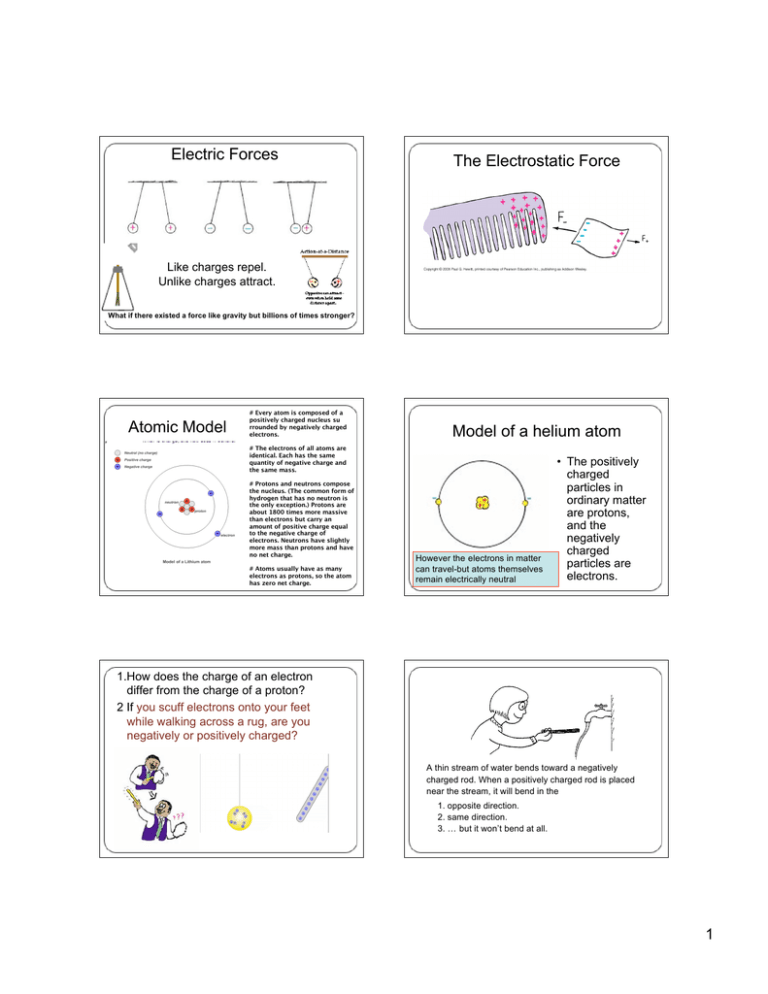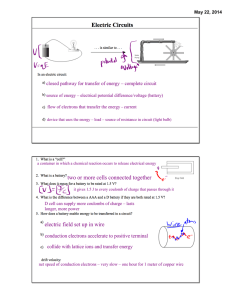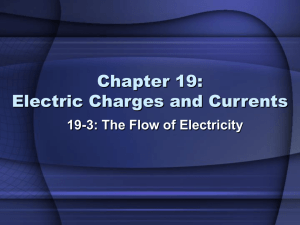Electric Forces The Electrostatic Force Atomic Model Model of a
advertisement

Electric Forces The Electrostatic Force Like charges repel. Unlike charges attract. What if there existed a force like gravity but billions of times stronger? Atomic Model # Every atom is composed of a positively charged nucleus su rrounded by negatively charged electrons. Model of a helium atom # The electrons of all atoms are identical. Each has the same quantity of negative charge and the same mass. # Protons and neutrons compose the nucleus. (The common form of hydrogen that has no neutron is the only exception.) Protons are about 1800 times more massive than electrons but carry an amount of positive charge equal to the negative charge of electrons. Neutrons have slightly more mass than protons and have no net charge. # Atoms usually have as many electrons as protons, so the atom has zero net charge. However the electrons in matter can travel-but atoms themselves remain electrically neutral • The positively charged particles in ordinary matter are protons, and the negatively charged particles are electrons. 1.How does the charge of an electron differ from the charge of a proton? 2 If you scuff electrons onto your feet while walking across a rug, are you negatively or positively charged? A thin stream of water bends toward a negatively charged rod. When a positively charged rod is placed near the stream, it will bend in the 1. opposite direction. 2. same direction. 3. … but it won’t bend at all. 1 Charging By Induction Coulomb’s law • It states that for two charged objects that are much smaller than the distance between them, the force between the two objects varies directly as the product of their charges and inversely as the square of the separation distance. The unit of charge is the coulomb, abbreviated C. It turns out that a charge of 1C is the charge associated with 6.25 million trillion electrons.1 C= 6.25 x1018 electrons Coulomb Constant • The proportionality constant k in Coulomb's law is similar to G in Newton's law of gravitation. Instead of being a very small number like • G =(6.67 × 10−11 N-m2/Kg2 ), Electric Force is 1024 times as big as gravitational force • the electrical proportionality constant k is a very large number. It is approximately or, in scientific notation, • k = 9 × 109 N-m2 /C2 . Check yourself • 1. The proton that is the nucleus of the hydrogen atom attracts the electron that orbits it. Does the electron attract the proton with the same amount of force, less force, or more force? • 2. If a proton is repelled by a charged particle with a given force, by how much will the force decrease if the proton is moved three times farther away from the particle? Five times farther away? • 3. What is the sign of charge of the particle in this case? 2 Conductors and Insulators The Electric Force and Field • It is easy to establish an electric current in metals because one or more of the electrons in the outer shell of its atoms are not anchored to the nuclei of particular atoms. Instead they are free to wander in the material. Such materials are called good conductors. Metals are good conductors of electric current for the same reason they are good heat conductors. Electrons in their outer atomic shell are loose. Insulators are not free to wander about among other atoms in the material. Electric Field http://www.colorado.edu/ph ysics/2000/applets/nforcefie ld.html • An electric field has both magnitude (strength) and direction. The magnitude of the field at any point is simply the force per unit of charge. If a body with charge q experiences a force F at some point in space, then the electric field E at that point is • Note that the lines emanate from the positive particle and terminate on the negative particle. Electric Shielding • Electric Field Inside any conductor is zero 3 Electric Potential • a) The spring has more mechanical PE when compressed. • (b) The charged particle similarly has more electrical PE when pushed closer to the charged sphere. In both cases the increased PE is the result of work input. + - The Volt • it is convenient when working with charged particles in an electric field to consider the electric potential energy per unit of charge. We simply divide the amount of potential energy in any case by the amount of charge. (N-m/C or Joules/C) The Battery Thus a 12-volt battery gives 12 joules of energy to every 1 coulomb of charge passing through the battery Check yourself 1. If there were twice as many coulombs in the test charge near the charged sphere in Figure 22.24, would the electric potential energy of the test charge with respect to the charged sphere be the same or would it be twice as great? Would the electric potential of the test charge be the same or would it be twice as great? 2. What does it mean to say that your car has a 12-volt battery? • The standard metric unit on electric potential difference is the volt, abbreviated V and named in honor of Alessandra Volta. One Volt is equivalent to one Joule per Coulomb. If the electric potential difference between two locations is 1 volt, then one Coulomb of charge will gain 1 joule of potential energy when moved between those two locations. If the electricpotential difference between two locations is 3 volts, then one coulomb of charge will gain 3 joules of potential energy when moved between those two locations. VanDeGraaff 10 C 100 C 4 Flow of Charge • Consider two spheres at a different potential. Charge flows from one end to the other if a conductor is connected + - Flow of Charge (N-m/C + - or Joules/C) Analogous to mass dropping in a gravitational field. It loses PE as it drops. Check Your Understanding • The battery simply supplies the energy to do work upon the charge to move it from the negative terminal to the positive terminal. By providing energy to the charge, the battery is capable of maintaining an electric potential difference across the two ends of the external circuit. The quantity electric potential is defined as the amount of _____ • a. electric potential energy • b. force acting upon a charge • c. potential energy per unit charge. • d. force per charge 5 Current • The rate of electrical flow is measured in amperes. One ampere is a rate of flow equal to 1 coulomb of charge per second. (Recall that 1 coulomb, the standard unit of charge, is the electric charge of 6.25 million trillion electrons.) In a wire that carries 5 amperes, for example, 5 coulombs of charge pass any cross section in the wire each second. So that's a lot of electrons! In a wire that carries 10 amperes, twice as many electrons pass any cross section each second. • I=Q/t (C/s) or Ampere Check Your Understanding • A 2 mm long cross section of wire is isolated and 20 C of charge are determined to pass through it in 40 s. • I=____ Amperes Check Your Understanding A current is said to exist whenever _____. • A. a wire is charged. • B. a battery is present • C. electric charges are unbalanced • D. electric charges move in a loop • In a hydraulic circuit, a narrow pipe (green) offers resistance to water flow. (right) In an electric circuit, a lamp or other device (shown by the zig zag symbol for resistance) offers resistance to electron flow. 6 The Ohm • Electrical resistance is measured in units called ohms. The Greek letter omega, Ω, is commonly used as the symbol for the ohm. An ohm is that amount of resistance when a volt results in a current of an amp i.e. Ohm’s Law: Analogous to a=F/m • Ohm discovered that the current (rate of flow of charge) in a circuit is directly proportional to the voltage established across the circuit, and is inversely proportional to the resistance of the circuit. • Ohm=Volt/amp • Check yourself • 1. How much current will flow through a lamp that has a resistance of 60 ohms when 12 V are impressed across it? • 2. What is the resistance of an electric frying pan that draws 12 A when connected to a 120-V circuit? • The bird can stand harmlessly on one wire of high potential, but it had better not reach over and grab a neighboring wire! Why not? Electric Shock • What causes electric shock in the human body current or voltage? • Check yourself • 1. At a resistance of 100,000 Ω, what will be the current in your body if you touch the terminals of a 12-volt battery? • 2. If your skin is very moist so that your resistance is only 1000 Ω and you touch the terminals of a 12-volt battery, how much current do you receive? 7 What causes electric shock, current or voltage? • The round prong connects the body of the appliance directly to ground (the earth). Any charge that builds up on an appliance is therefore conducted to the groundム preventing accidental shock. Electric Circuits Series Circuits: Water Analogy • Series Circuits As more resistors (bulbs) are added, resistance gets bigger, current gets smaller (dimmer) RT=R1+R2 +R3 1.What happens to current in other lamps if one lamp in a series circuit burns out? 2. What happens to the light intensity of each lamp in a series circuit when more lamps are added to the circuit? Parrallel Circuits I = V/R Parallel Circuits: Water Analogy As R gets bigger, total resistance gets smaller. Total Resistance is smaller than the smallest resistor. 8 Demo: Electric Circuits A Problem Two 10 ohm bulbs are connected in series to a 20 V battery. What is the total resistance and what current flows? Two 10 ohm bulbs are connected in parallel to a 20 V battery. What is the total resistance and what current flows? • 1.Each device connects the same two points A and B of the circuit. The voltage is therefore the same across each device. • 2.The total current in the circuit divides among the parallel branches. Since the voltage across each branch is the same, the amount of current in each branch is inversely proportional to the resistance of the branchム Ohm's law applies separately to each branch. • 3.The total current in the circuit equals the sum of the currents in its parallel branches. • 4.As the number of parallel branches is increased, the overall resistance of the circuit is decreased. Overall resistance is lowered with each added path between any two points of the circuit. This means the overall resistance of the circuit is less than the resistance of any one of the branches. • Lights and wall outlets are connected in parallel, so all are impressed with the same voltage, usually about 110ミ 120 volts. As more devices are plugged in and turned on, more pathways for current result in lowering of the combined resistance of each circuit. Therefore, a greater amount of current occurs in the circuits. The sum of these currents equals the line current, which may be more than is safe. The circuit is then said to be overloaded. The heat generated by an overloaded circuit may start a fire. • Check yourself • 1. What happens to the current in other lamps if one of the lamps in a parallel circuit burns out? • 2. What happens to the light intensity of each lamp in a parallel circuit when more lamps are added in parallel to the circuit? Review Questions So what is ______. a Coulomb: a Volt: Current: Amp: Ohm’s Law A 6 volt battery is connected to a 2 ohm lamp. What is the current thru the lamp? Voltage across the lamp? 9 Review Questions A 6 volt battery is connected to three 2 ohm lamps. What is the current thru each lamp? Voltage across each lamp? Review Questions Review Questions A 6 volt battery is connected to two 2 ohm lamps as shown below with switch open. Repeat with switch closed. •Voltage across the lamp? •What is the current thru each lamp? •Total current put out by battery? Direct Current and Alternating Current A 1 ohm lamp is connected across the 12 V batter. If another 60 ohm lamp is connected in parallel then the total resistance in the circuit: In a parallel circuit the •Is more than 60 ohms total resistance is •Is less than 1 ohm smaller than the smallest resistance •remains the same Electric Power 10 • When it is observed that a light bulb is rated at 60 watts, then there are 60 joules of energy delivered to the light bulb every second. A 120-watt light bulbs draws 120 joules of energy every second The power and voltage on the light bulb read 100 W 120 V. How many amperes will flow through the bulb? The Kilowatt-hour • A kilowatt is a unit of power and an hour is a unit of time. So a kilowatt ・ hour is a unit of Power ・ time. If Power = Energy / time, then Power ・ time = Energy. So a unit of power ・ time is a unit of energy. The kilowatt ・ hour is a unit of energy. When an electrical utility company charges a household for the electricity which they used, they are charging them for electrical energy. The utility company is responsible for assuring that the electric potential difference across the two main wires of the house is 110 to 120 volts. And maintaining this difference in potential requires energy. • Check yourself • 1. If a 120-V line to a socket is limited to 15 A by a safety fuse, will it operate a 1200-W hair dryer? • 2. At 10 cents/kWh, what does it cost to operate the 1200-W hair dryer for 1 hr? 11





